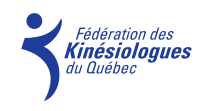The kinesiologist has a bachelor's degree at the university level whose main purpose is to study kinesiology. When the kinesiologist completes his university education at the bachelor's level, he has general knowledge that allows him to have a basic intervention with all the clientele he serves, and this, in prevention, Rehabilitation, performance, and lifestyle's modification.
UNIVERSITY TRAINING
The Bachelor of Kinesiology covers various topics such as:
-
human anatomy
-
engine growth and development
-
biomechanics of human movement
-
motor control and learning
-
assessment of fitness and lifestyle
-
training methods, prescription, periodization
-
physiology of exercise
-
psychology of physical activity and sport
-
sports nutrition
-
Research Methodology
-
promotion of physical activity
The ten universities recognized for training kinesiologists in Quebec are:
- Université de Montréal
- Université Laval
- Université du Québec à Montréal
- Université de Sherbrooke
- Université McGill
- Université Concordia
- Université du Québec à Trois-Rivières
- Université du Québec à Chicoutimi
- Université du Québec à Rimouski
- Université du Québec en Outaouais
Thereafter, the kinesiologist always has the opportunity to specialize through further training at the graduate and post-graduate levels.
HIS COMPETENCES
The skills expected of the kinesiologist during their training have been established based on the stages of a client's journey with a health professional in Quebec. Here they are:
Search for relevant information to determine the individual's needs and intervention objectives:
-
Identify the individual's needs and goals;
-
Interpret the individual's needs and goals to evaluate, measure and achieve them;
-
Research and analyze relevant information prior to the intervention.
Evaluate an individual's functional capacity, motor skills, and physical fitness determinants to develop an intervention plan:
-
Identify and perform appropriate tests to evaluate an individual's functional capacity, motor skills;
-
Apply appropriate tests to evaluate the functional ability, motor skills and determinants of the individual's physical condition;
-
Analyze test results;
-
Write a report based on the clinical analysis.
Build a specific intervention plan:
-
Establish priorities for intervention with the individual;
-
Formulate realistic goals aligned with the individual's goals;
-
Identify appropriate intervention strategies and techniques that enable the client to achieve the intended objectives;
-
Establish a realistic timeline for his interventions.
Perform your intervention effectively:
-
Know the strategies and techniques of intervention;
-
Apply strategies and intervention techniques effectively.
Have a critical look at his intervention and, if necessary, readjust his intervention:
-
Evaluate the effects of his interventions;
-
Assess the adequacy between the effects of its interventions and the objectives were chosen;
-
Readjust his interventions as needed.
Act ethically and responsibly:
-
Communicate appropriately (orally and in writing) with colleagues in the same discipline and other disciplines;
-
Communicate appropriately (orally and in writing) with the client;
-
Make a disciplinary contribution in a collaborative situation;
-
Identify and plan training relevant to his / her continuing education;
-
Analyze your professional capacity before acting with the individual (his strengths, limitations, the scope of practice), consult other professionals if necessary or refer;
-
Know and respect the ethical standards of the profession;
-
Respect individuals, colleagues, and other stakeholders and avoid any form of discrimination against others;
-
Carry out promotion, education, and prevention of health activities adapted to a designated population.





